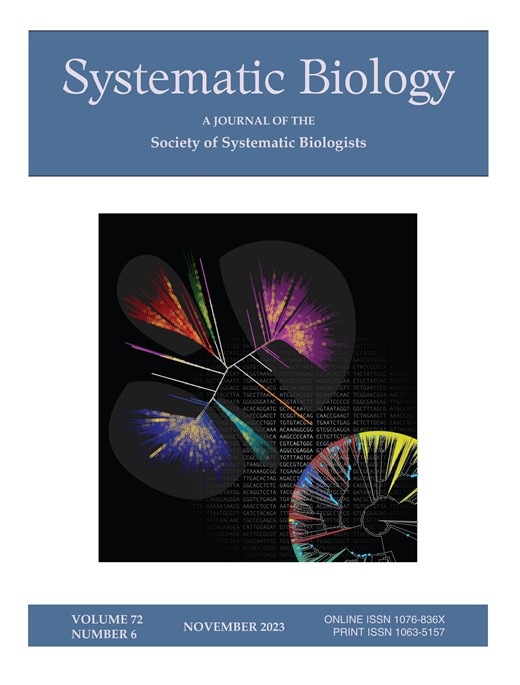Mechanisms of Community Assembly through the lens of Phylogenetic Diversity: a Critical Reappraisal
IF 5.7
1区 生物学
Q1 EVOLUTIONARY BIOLOGY
引用次数: 0
Abstract
Darwin was one of the first to hypothesize a connection between niche differentiation and competition and species relatedness, offering an appealing framework to disentangle community assembly processes based on phylogenetic diversity patterns. Community assembly is, however, the result of several processes including potentially confounding factors associated with dispersal limitations and spatial effects, casting doubt about the application of phylogenetic diversity metrics to infer community assembly processes. We implemented a spatially-explicit model involving limited dispersal, drift, trait-based selection and competition to simulate community composition under competing assembly processes in a landscape with contrasted habitat connectivity. The phylogenetic structure of communities globally varied depending on assembly processes and the combination thereof, validating the assumption, made by a large number of studies but seldom tested in a spatially-explicit context, that different assembly processes indeed lead to significantly different patterns of community phylogenetic structure. All the investigated alpha metrics exhibited a poor ability to detect overdispersion under stabilizing processes, and some even unduly recovered a signal of clustering. Some of the most widely used metrics, such as UniFrac, carry a redundant signal with non-phylogenetic metrics, and hence, poorly capture the phylogenetic signal in the data. We identified three metrics, namely Bst or Pst for abundance data and PIst for occurrence data, which best retrieved the correct signal of phylogenetic structure under different assembly processes. Spatial effects may blur the phylogenetic structure of communities and decrease our ability to infer underlying processes. However, meaningful results may be obtained when the appropriate comparisons are made. In particular, phylogenetic clustering under equalizing processes must be tested on inter-habitat comparisons because it is the differential filtering of species between habitats that reveals the impact of equalizing processes. Our simulations further suggest that a significant phylogenetic structure of communities can be retrieved even in species-poor communities, except when the communities being compared are dominated by a single, most abundant species. We therefore conclude with best practices to adequately infer assembly processes with useful phylogenetic diversity metrics.系统发育多样性视角下的群落聚集机制:一个重要的再评价
达尔文是第一个假设生态位分化与竞争和物种亲缘关系之间存在联系的人之一,他提供了一个有吸引力的框架来解开基于系统发育多样性模式的群落组装过程。然而,群落聚集是几个过程的结果,包括与扩散限制和空间效应相关的潜在混淆因素,这使人们对系统发育多样性指标在推断群落聚集过程中的应用产生了怀疑。我们实施了一个空间显式模型,包括有限的扩散、漂移、基于性状的选择和竞争,以模拟具有对比栖息地连通性的景观中竞争组装过程下的群落组成。全球群落的系统发育结构因装配过程及其组合而异,这证实了大量研究提出的假设,即不同的装配过程确实导致了显著不同的群落系统发育结构模式,但很少在空间明确的背景下进行测试。所有研究的alpha指标在稳定过程中都表现出较差的检测过分散的能力,有些甚至不适当地恢复聚类信号。一些最广泛使用的指标,如UniFrac,带有非系统发育指标的冗余信号,因此很难捕获数据中的系统发育信号。我们确定了三个指标,即丰度数据的Bst或Pst和发生率数据的ist,它们最能准确地检索不同装配过程下的系统发育结构信号。空间效应可能模糊群落的系统发育结构,降低我们推断潜在过程的能力。然而,当进行适当的比较时,可能会得到有意义的结果。特别是,平衡过程下的系统发育聚类必须在生境间比较中进行测试,因为它是生境间物种的差异过滤,揭示了平衡过程的影响。我们的模拟进一步表明,即使在物种贫乏的群落中,也可以检索到群落的重要系统发育结构,除非被比较的群落由单一的、最丰富的物种主导。因此,我们总结了最佳实践,以充分推断装配过程与有用的系统发育多样性指标。
本文章由计算机程序翻译,如有差异,请以英文原文为准。
求助全文
约1分钟内获得全文
求助全文
来源期刊

Systematic Biology
生物-进化生物学
CiteScore
13.00
自引率
7.70%
发文量
70
审稿时长
6-12 weeks
期刊介绍:
Systematic Biology is the bimonthly journal of the Society of Systematic Biologists. Papers for the journal are original contributions to the theory, principles, and methods of systematics as well as phylogeny, evolution, morphology, biogeography, paleontology, genetics, and the classification of all living things. A Points of View section offers a forum for discussion, while book reviews and announcements of general interest are also featured.
 求助内容:
求助内容: 应助结果提醒方式:
应助结果提醒方式:


